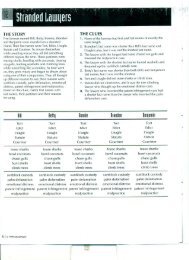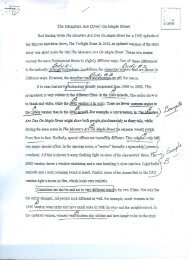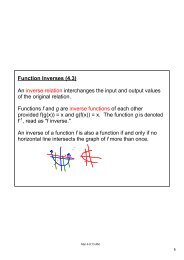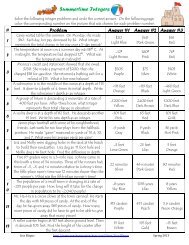Rosencrantz and Guildenstern Are Dead - Cherokee County Schools
Rosencrantz and Guildenstern Are Dead - Cherokee County Schools
Rosencrantz and Guildenstern Are Dead - Cherokee County Schools
Create successful ePaper yourself
Turn your PDF publications into a flip-book with our unique Google optimized e-Paper software.
step in moving theatre out of the abyss of absurdity." Though certainly working in the context of the absurdist<br />
theatre movement of the 1950s <strong>and</strong> early 1960s, Stoppard's first major drama must not be too easily subsumed<br />
under its heading.<br />
Critical Overview<br />
When <strong>Rosencrantz</strong> <strong>and</strong> <strong>Guildenstern</strong> <strong>Are</strong> <strong>Dead</strong> premiered in Edinburgh <strong>and</strong> London in August of 1966 <strong>and</strong> in<br />
April of 1967, Tom Stoppard was immediately recognized as a major contemporary playwright. The<br />
cleverness in the concept of the play, its verbal dexterity, <strong>and</strong> its phenomenal theatricality brought its first<br />
reviewer, Ronald Bryden, to call it "the most brilliant debut by a young playwright since John Arden." Later,<br />
in London, Irving Wardle, writing for the Guardian, said that "as a first stage play it is an amazing piece of<br />
work," <strong>and</strong> in New York, Harold Clurman, reviewing the play in Nation, echoed the general sentiment by<br />
calling Stoppard's play a "scintillating debut." And Clive Barnes, the highly influential critic for the New York<br />
Times, asserted in October of 1967 that "in one bound Mr. Stoppard is asking to be considered as among the<br />
finest English-speaking writers of our stage, for this is a work of fascinating distinction."<br />
However, as enthusiastic as critics were for this dazzling first effort, they also had some very clear<br />
reservations. Generally, they thought Stoppard's play somewhat derivative, too closely linked to Beckett's<br />
Waiting for Godot, for example. Bryden found the play "an existentialist fable unabashedly indebted to<br />
Waiting for Godot" <strong>and</strong> the appreciative Clurman called it "Waiting for Godot rewritten by a university wit."<br />
Also in New York, an appreciative Charles Marowitz writing for the Village Voice added,"my only objection<br />
is that without the exhilarating stylistic device of the play-beneath-the-play, the play proper would be very<br />
much second-h<strong>and</strong> Beckett." Michael Smith, also writing for the Village Voice, applauded the play, saying<br />
"the writing is brilliantly clever, the basic trick inspires a tour de force, <strong>and</strong> the play is great fun,'' but added,<br />
"the drawback is Stoppard's attempt to push it to deep significance. The early part of the play repeatedly<br />
echoes Waiting for Godot in sound <strong>and</strong> situation but entirely lacks its resonance."<br />
Another reservation the critics voiced was the suggestion that the play's verbal dexterity <strong>and</strong> ingenious<br />
theatricality might have been all it had to offer, that underneath the dazzling surface there was very little of<br />
substance <strong>and</strong> that the play was ultimately shallow. This was suggested by Philip Hope-Wallace reviewing the<br />
first London production for the Guardian when he said, "I had a sensation that a fairly pithy <strong>and</strong> witty<br />
theatrical trick was being elongated merely to make an evening of it." And despite his generous praise for<br />
Stoppard's play, Charles Marowitz added that "much of its cross-talk is facile wordmanship that benefits<br />
accidentally from ambiguity."<br />
Writing somewhat after the initial critical response to the play, critics Robert Brustein <strong>and</strong> John Simon<br />
summed up this ambivalent response. Brustein wrote,"I advance my own reservations feeling like a spoilsport<br />
<strong>and</strong> a churl: the play strikes me as a noble conception which has not been endowed with any real weight or<br />
texture," <strong>and</strong> in a now often quoted remark, Brustein calls Stoppard's play "a theatrical parasite, feeding off<br />
Hamlet, Waiting for Godot <strong>and</strong> Six Characters in Search of an Author—Shakespeare provided the characters,<br />
Pir<strong>and</strong>ello the technique, <strong>and</strong> Beckett the tone with which the Stoppard play proceeds." Similarly, critic John<br />
Simon writing for The Hudson Review admitted that "the idea of the play is a conception of genius'' but also<br />
saw it as "squeezing large chunks of Beckett, Pinter, <strong>and</strong> Pir<strong>and</strong>ello, like sliding bulges on a python as he<br />
digests rabbits swallowed whole," finally reducing Stoppard's play to "only cleverness <strong>and</strong> charm."<br />
More than 30 years later, this ambivalent assessment continues to hang over Stoppard's work in general <strong>and</strong><br />
over <strong>Rosencrantz</strong> <strong>and</strong> <strong>Guildenstern</strong> <strong>Are</strong> <strong>Dead</strong> in particular. In varying degrees, critics have leveled similar<br />
charges upon successive major plays—Jumpers (1972), Travesties (1974), The Real Thing (1982), Hapgood<br />
(1988), <strong>and</strong> Arcadia (1993), frequently assessing them as excessively concerned with cleverness <strong>and</strong> the<br />
arcane, too cerebral, lacking in genuine emotion, <strong>and</strong> ultimately shallow when measured against a very high<br />
Critical Overview 9
















